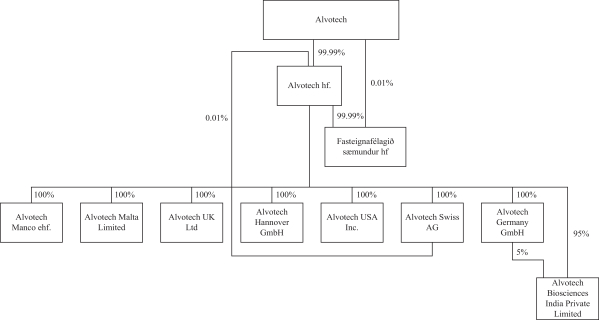The information in this preliminary prospectus is not complete and may be changed. The selling securityholders may not sell these securities until the registration statement filed with the Securities and Exchange Commission is effective. This preliminary prospectus is not an offer to sell these securities and we are not soliciting an offer to buy these securities in any jurisdiction where the offer or sale is not permitted.
Subject to Completion, dated March 13, 2023
PRELIMINARY PROSPECTUS

Up to 10,916,647 Ordinary Shares Issuable Upon Exercise of Warrants
Up to 219,616,200 Ordinary Shares Offered by Selling Securityholders
Up to 4,666,667 Warrants to purchase Ordinary Shares offered by the Sponsor
This prospectus relates to the issuance by us of 10,916,647 Ordinary Shares consisting of (i) 6,249,980 of our ordinary shares, $0.01 nominal value, (“Ordinary Shares”) that may be issued upon exercise of warrants to purchase Ordinary Shares at an exercise price of $11.50 (the “Public Warrants”), which were originally issued in the initial public offering of Oaktree Acquisition Corp. II (“OACB”) at a price of $10.00 per unit, with each unit consisting of one OACB Class A Ordinary Share (as defined below) and one-fourth of a Public Warrant, and (ii) 4,666,667 Ordinary Shares that may be issued upon exercise of warrants issued to Oaktree Acquisition Holdings II, L.P. (the “Sponsor”), and its transferees to purchase Ordinary Shares at an exercise price of $11.50 (the “Private Placement Warrants”). We refer to the Public Warrants and the Private Placement Warrants together as the “Warrants.” The Warrants were originally issued by OACB entitling the holder to purchase one share of the OACB Class A Ordinary Shares (as defined below) at an exercise price of $11.50 per share (“OACB Warrants”) and automatically converted into Warrants on substantially the same terms as the OACB Warrants, entitling the holder to purchase our Ordinary Shares, on the closing of the Business Combination among us, OACB and Alvotech Holdings S.A. (“Alvotech Holdings”) The Business Combination is defined and described in greater detail in this prospectus. See “Prospectus Summary–Recent Developments–Business Combination.”
This prospectus also relates to the offer and sale from time to time by the selling securityholders named in this prospectus (collectively, the “Selling Securityholders”), or their permitted transferees, of up to (i) 17,493,000 Ordinary Shares subscribed for by the Selling Securityholders, for a subscription price of $10.00 per share, in the context of the PIPE Financing (as defined below), (ii) 6,250,000 Ordinary Shares issued to the Sponsor in exchange for OACB’s Class B Ordinary Shares, par value $0.0001 (the “OACB Class B Ordinary Shares” or the “Founder Shares”) (which were purchased by the Sponsor for $25,000 or approximately $0.004 per share) in connection with the Business Combination, (iii) 4,666,667 Ordinary Shares issuable upon exercise of Private Placement Warrants, (iv) 186,206,553 Ordinary Shares issued to former shareholders of Alvotech Holdings in exchange for their Alvotech Holdings Ordinary Shares in connection with the Business Combination (subject to vesting and lockups) at an equity consideration value of $10.00 per share, (v) 5,000,000 Ordinary Shares subscribed for by Alvogen and Aztiq, for a subscription price of $10.00 per share, in the context of the Alvogen-Aztiq Loan Advance Conversion (as defined below), and (vi) 4,666,667 Private Placement Warrants, which were purchased by the Sponsor at a price of $1.50 per warrant.
Concurrently with the execution of the Business Combination Agreement, OACB and Alvotech entered into subscription agreements with certain U.S.-based institutional and accredited investors (each a “U.S. Subscription Agreement”) and non-U.S. persons (as defined in Regulation S under the Securities Act (each a “Foreign Subscription Agreement” and, together with the U.S. Subscription Agreements, the “Initial Subscription Agreements”) with certain investors (the “Initial Subscribers”), pursuant to which the Initial Subscribers have agreed to subscribe for, and Alvotech has agreed to issue to the Initial Subscribers, an aggregate of 15,393,000 Ordinary Shares at a price of $10.00 per share, for aggregate gross proceeds of $153,930,000 (the “Initial PIPE Financing”). Subsequent to the Initial PIPE Financing, on January 18, 2022, OACB and Alvotech entered into Subscription Agreements (the “Subsequent Subscription Agreements”, and together with the Initial Subscription Agreements, the “Subscription Agreements”) with certain investors (the “Subsequent Subscribers”, and together with the Initial Subscribers, the “Subscribers” or the “Selling Securityholders”), pursuant to which the Subsequent Subscribers have agreed to subscribe for, and Alvotech has agreed to issue to the Subsequent Subscribers, an aggregate of 2,100,000 Ordinary Shares at a price of $10.00 per share, for aggregate gross proceeds of $21,000,000 (the “Subsequent PIPE Financing”, and together with the Initial PIPE Financing, the “PIPE Financing”). The aggregate number of Ordinary Shares to be issued pursuant to the PIPE Financing was 17,493,000 for aggregate gross proceeds of $174,930,000. The Subscription Agreements contain substantially the same terms, except that the investors that entered into the Foreign Subscription Agreement agreed to subscribe for Ordinary Shares at a price that is net of a 3.5% placement fee. The Business Combination is described in greater detail in this prospectus. See “Prospectus Summary–Recent Developments–Business Combination.”

